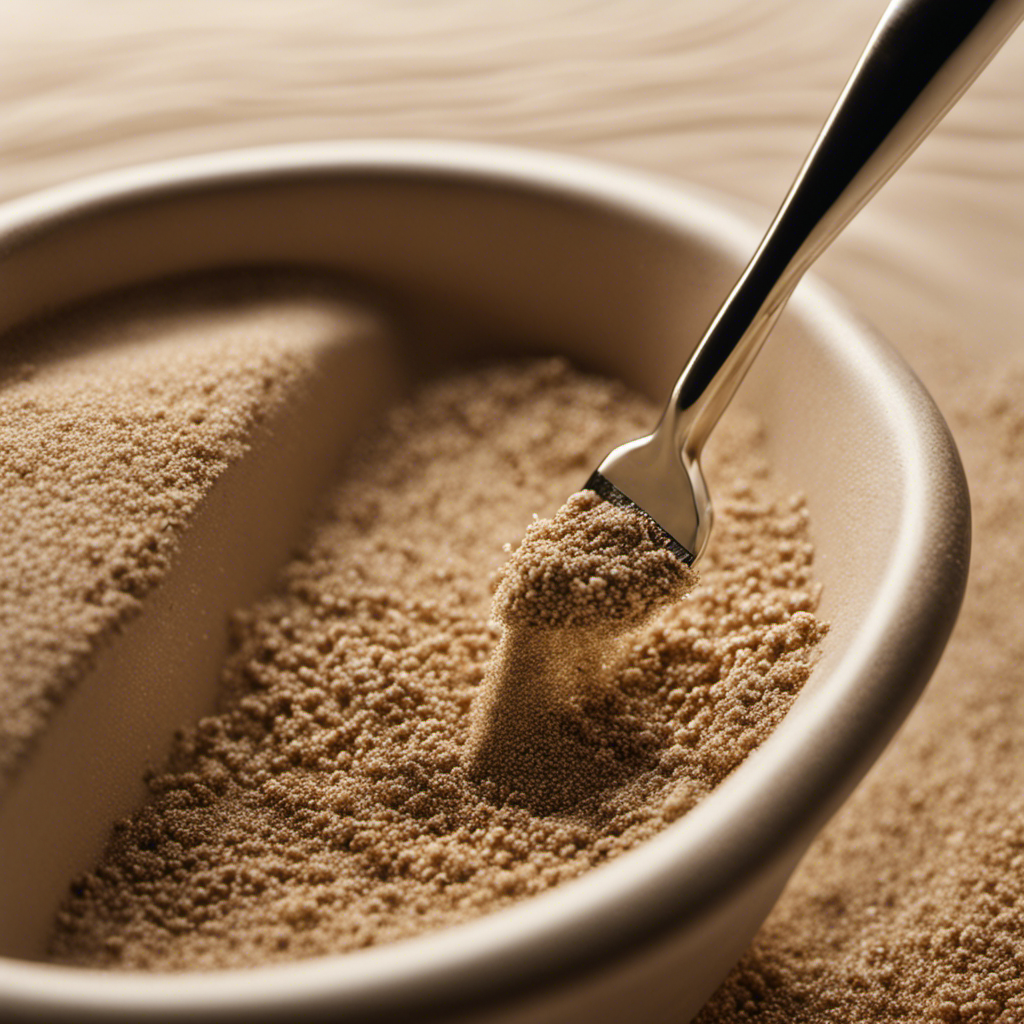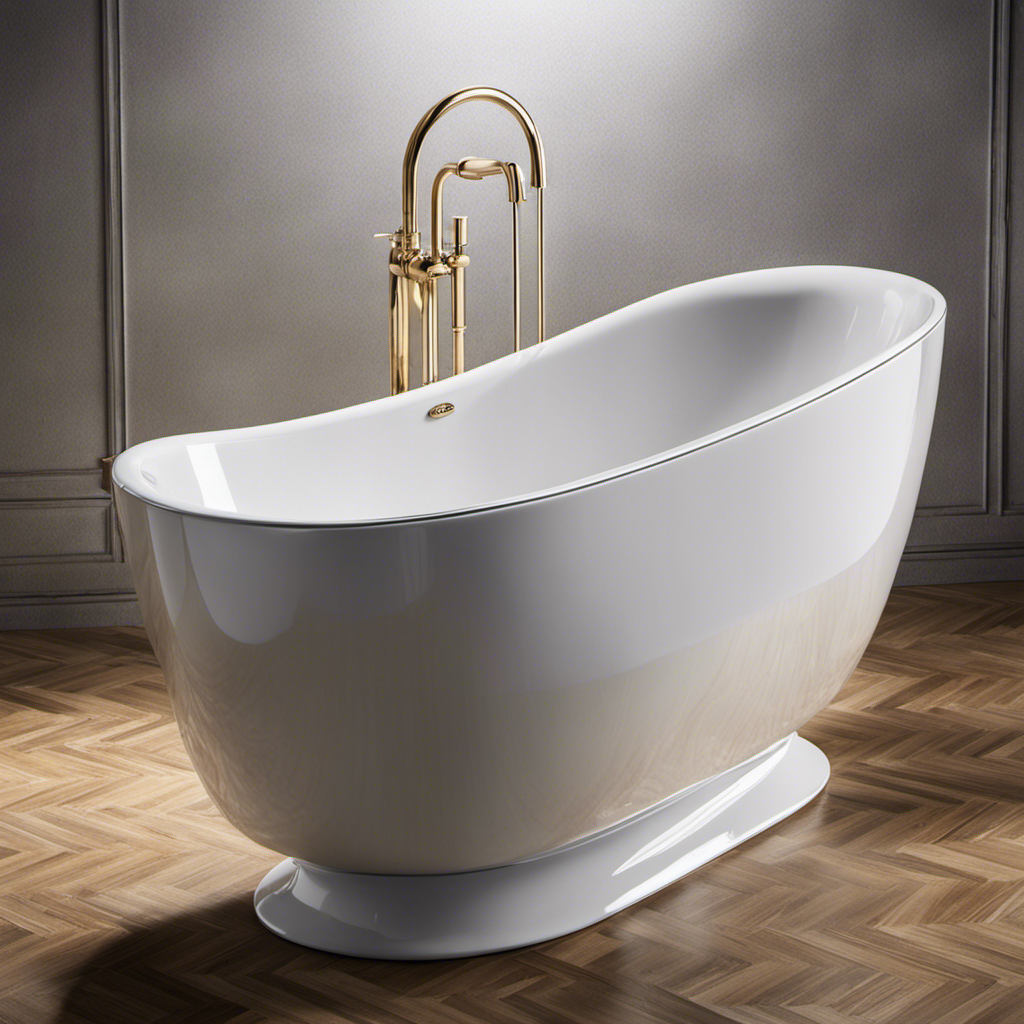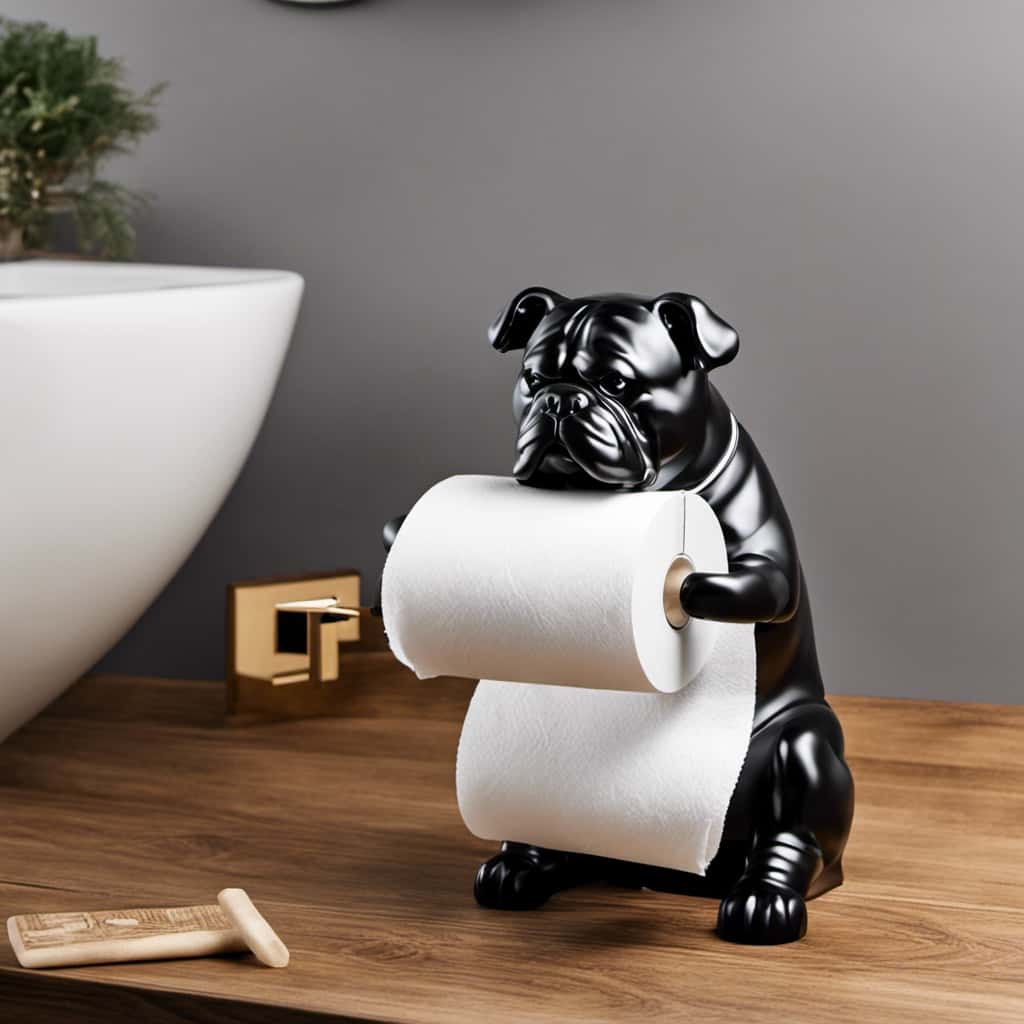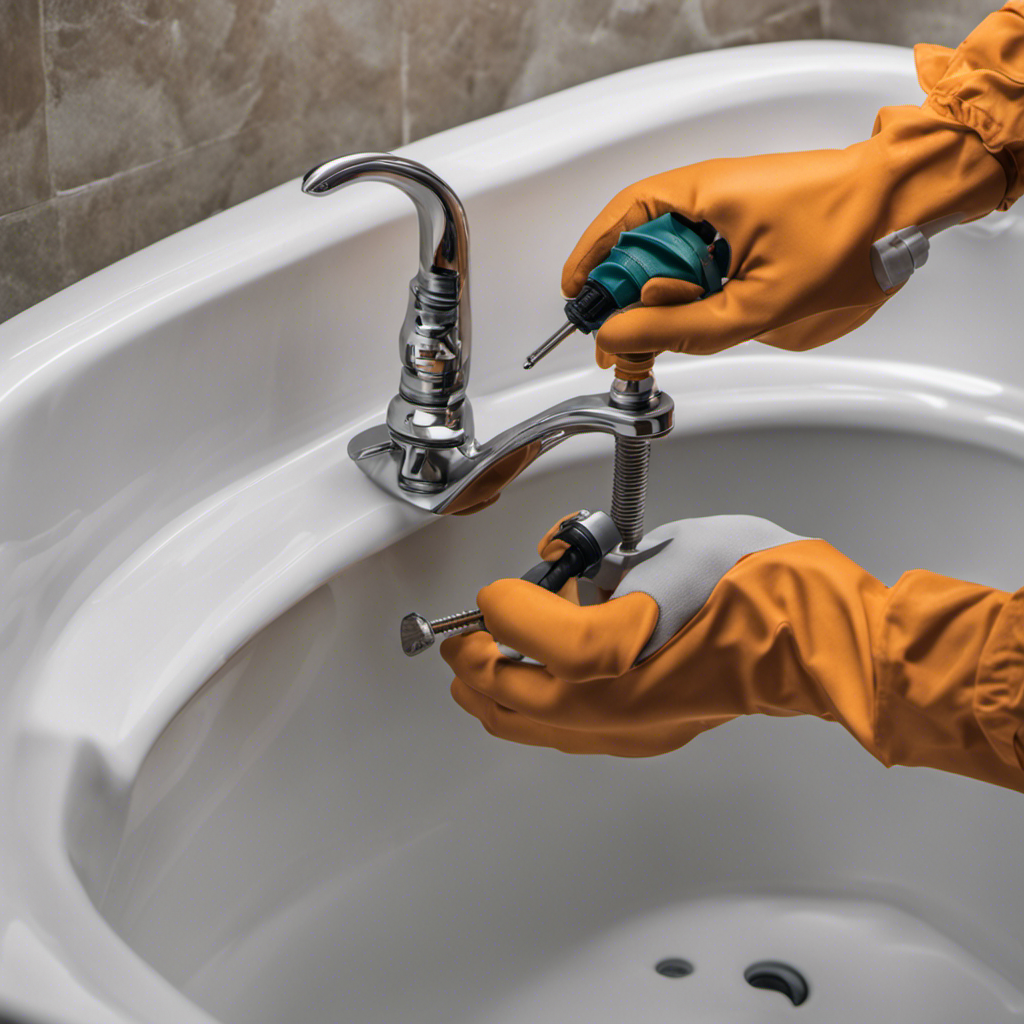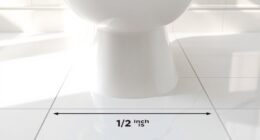So, you’ve just come back from a relaxing day at the beach, only to find that your bathtub drain is clogged with pesky sand. Well, fear not! I’m here to share with you a foolproof method to get that sand out and restore your drain to its pristine condition.
In this article, I’ll guide you through each step, from assessing the situation to preventing future sand buildup. With the right tools and a little know-how, you’ll have that drain flowing smoothly in no time.
Let’s dive in!
Key Takeaways
- Assess the situation and determine the cause and severity of the sand clog.
- Gather necessary tools such as a plunger, drain snake, and drain cleaning solution.
- Follow a step-by-step guide for using a plunger to unclog the drain.
- Practice regular maintenance and preventative measures to avoid future sand clogs.
Assess the Situation
First, check if the water is draining slowly or completely blocked. Assessing the damage is crucial in tackling the problem effectively.
If the water is draining slowly, it indicates a partial blockage, while a complete blockage means the water is not draining at all.
Next, determine the cause of the blockage. In the case of sand in the bathtub drain, it is likely that it has accumulated over time and is now causing the obstruction. Understanding the cause will help in choosing the appropriate method to remove the sand.
Now that you have assessed the situation and know what you are dealing with, it’s time to gather the necessary tools to unclog the drain efficiently.
Gather Necessary Tools
When it comes to cleaning and unclogging drains, having the right supplies is essential.
In order to effectively tackle any clog, it’s important to gather the necessary tools such as a plunger, drain snake, and drain cleaning solution.
Once the clog is cleared, taking preventative measures can help avoid future clogs and keep your drains flowing smoothly.
Essential Cleaning Supplies
To effectively clean the bathtub drain, you’ll need a few essential supplies. First, grab a pair of rubber gloves to protect your hands from any dirt or grime. Next, you’ll need a plunger or a drain snake to physically remove any clogs. A bucket or a large bowl will come in handy to catch any water or debris that might splash out during the cleaning process. It’s also important to have a bottle of vinegar and baking soda on hand, as these natural cleaning agents can help break down any buildup in the drain. Finally, don’t forget a sponge or scrub brush to scrub away any remaining residue. By having these essential cleaning supplies ready, you’ll be well-prepared to tackle any bathtub drain clogs.
When it comes to cleaning the bathtub drain, there are a few common mistakes to avoid. One of the most common mistakes is pouring harsh chemical cleaners down the drain. These cleaners can damage the pipes and cause further clogs. Another mistake is neglecting regular maintenance. It’s important to clean the drain regularly to prevent buildup and clogs from occurring in the first place. Additionally, using too much force when using a plunger or drain snake can cause damage to the pipes. It’s best to use gentle, controlled motions when attempting to clear a clog. Lastly, be mindful of what goes down the drain. Avoid pouring grease, hair, or large particles down the drain to prevent clogs from forming. By avoiding these common cleaning mistakes, you’ll be able to effectively clean your bathtub drain and keep it running smoothly.
Effective Drain Unclogging
One effective way to unclog your bathtub drain is by using a plunger. Assessing the severity of the clog is the first step in determining the right approach. If the water is draining slowly, it indicates a partial clog that can be easily resolved with a plunger.
Here’s a step-by-step guide on DIY drain unclogging using a plunger:
- Fill the bathtub with enough water to cover the plunger head.
- Place the plunger over the drain and ensure a tight seal.
- Push and pull the plunger vigorously to create suction.
- Repeat this motion for about 20-30 seconds.
- Remove the plunger and check if the water drains freely.
By following these simple steps, you can unclog your bathtub drain without the need for professional help. However, it’s important to note that severe clogs may require additional methods such as using a drain snake or calling a plumber.
Now, let’s move on to the next section where we will discuss preventive measures to avoid future clogs.
Preventing Future Clogs
To prevent future clogs in your bathtub drain, it’s essential to practice regular maintenance and avoid disposing of substances that can cause blockages.
One effective way to prevent sand accumulation in your drain is by using drain screens. These screens are designed to catch debris, including sand, before it enters the drainpipe. By installing a drain screen, you can significantly reduce the amount of sand that accumulates in your drain and minimize the risk of clogs.
Additionally, make sure to clean the drain screens regularly to remove any trapped sand or debris. By taking these preventive measures, you can ensure that your bathtub drain remains clear and free from sand clogs.
Now, let’s move on to the next step: removing visible sand from the drain.
Remove Visible Sand From the Drain
You can easily get the sand out of the bathtub drain by using a plunger. Here are some steps to follow:
-
First, remove any excess sand that is visible on the surface of the drain. You can do this by using a small brush or your fingers to gently sweep away the sand particles.
-
Once you have removed the excess sand, fill the bathtub with enough water to cover the plunger cup.
-
Place the plunger over the drain and make sure it forms a tight seal.
-
Push down firmly on the plunger and then quickly pull up. Repeat this plunging motion several times to create suction and dislodge the sand from the drain.
-
After a few attempts, check the drain to see if the sand has been cleared. If not, continue plunging until the drain is clear.
Use a Plunger to Dislodge Stubborn Sand
When it comes to dealing with stubborn sand clogs in the drain, the plunger technique can be quite effective. By creating a strong suction and pushing force, the plunger can dislodge the sand and allow it to flow out of the drain.
However, it is important to also focus on preventing future drain clogs by implementing simple habits such as using a drain cover or regularly cleaning the drain.
In addition to the plunger technique, there are alternative methods for sand removal, such as using a wet/dry vacuum or a drain snake, which can be explored for more stubborn clogs.
Plunger Technique Effectiveness
The plunger can be really effective in getting sand out of the bathtub drain. I have personally used this technique and found it to be quite successful. Here are a few tips to ensure maximum effectiveness when using a plunger:
- Make sure the plunger cup completely covers the drain opening.
- Apply firm, downward pressure while rapidly plunging up and down.
- Create a tight seal by applying petroleum jelly to the rim of the plunger cup.
- If the sand is particularly stubborn, try using a plunger with a flange for added suction.
While the plunger technique is effective, there are alternative methods to consider as well. Regular drain maintenance is crucial in preventing sand buildup. Here are some tips for maintaining a sand-free bathtub drain:
- Install a drain cover to catch larger particles of sand.
- Use a hair strainer in the shower to prevent hair and sand from entering the drain.
- Flush the drain regularly with hot water to help dislodge any sand particles.
Preventing Future Drain Clogs
Now that we’ve discussed the effectiveness of the plunger technique for removing sand from a bathtub drain, let’s explore some preventive measures to avoid future clogs.
Regular drain maintenance is key to keeping your drains clear and flowing smoothly. One simple step you can take is to install drain covers in your bathtub and other drains throughout your home.
These covers act as a barrier, preventing larger debris such as sand, hair, and soap scum from entering the drain and causing blockages. They are easy to install and can be found at your local home improvement store.
By using drain covers and periodically cleaning them, you can significantly reduce the chances of experiencing clogged drains.
Alternative Sand Removal Methods
Another option for removing sand from your bathtub drain is using a wet/dry vacuum. This method is effective and can be done easily with the right equipment. Here’s how to do it:
- First, make sure you have a wet/dry vacuum with a hose attachment.
- Attach the hose to the vacuum and insert it into the drain.
- Turn on the vacuum and let it suck up the sand from the drain.
- Move the hose around to ensure all the sand is removed.
- Empty the contents of the vacuum into a trash bag or container.
- Repeat the process if necessary until all the sand is gone.
Using a wet/dry vacuum is a DIY drain cleaning technique that allows you to remove sand efficiently without causing any damage to your plumbing system. Give it a try and enjoy a sand-free bathtub drain!
Flush the Drain With Hot Water
First, you’ll want to turn on the hot water and let it run for a few minutes to flush the drain. This is an essential step in removing sand from your bathtub drain. The hot water will help to loosen and dislodge any trapped sand particles, allowing them to flow out of the drain more easily.
While flushing the drain, it’s important to assess the damage caused by the sand accumulation. Check for any signs of clogging or water backup.
If the problem persists even after flushing the drain, it may be necessary to call a professional plumber. They have the expertise and tools to tackle more severe blockages and ensure your drain is sand-free.
Apply a Homemade Drain Cleaner
To apply a homemade drain cleaner, you’ll need to gather a few simple ingredients and follow these easy steps. Here’s how to make and use an eco-friendly drain cleaner alternative:
-
Ingredients:
-
Baking soda
-
Vinegar
-
Steps:
- Start by pouring half a cup of baking soda down the drain.
- Follow it up with half a cup of vinegar.
- Let the mixture sit in the drain for about 30 minutes.
- After 30 minutes, flush the drain with hot water.
Using this homemade drain cleaner is a safe and effective way to clear clogs caused by sand or other debris. The baking soda and vinegar work together to break down the sand and other particles, clearing the drain without the need for harmful chemicals.
Once you’ve successfully removed the sand from your bathtub drain, it’s important to take steps to prevent future buildup.
Prevent Future Sand Buildup
Now that you’ve learned how to remove sand from your bathtub drain, let’s talk about how to prevent future buildup. By taking some simple steps, you can maintain the cleanliness of your drain and avoid the hassle of clogs caused by sand accumulation.
One effective method is to use a drain cover or strainer. These inexpensive devices sit over your drain and catch any debris, including sand, before it has a chance to go down the drain. This not only prevents clogs but also makes cleaning your drain easier.
Another way to prevent sand buildup is to rinse off sandy items before they enter the bathtub. For example, after a day at the beach, make sure to rinse off beach toys, swimsuits, and yourself in an outdoor shower or with a garden hose before entering the bathroom.
By implementing these preventative measures, you can keep your drain clean and sand-free, saving yourself time and frustration in the long run.
| Preventative Measures |
|---|
| Use a drain cover or strainer |
| Rinse off sandy items before entering the bathtub |
Conclusion
In conclusion, dealing with sand in the bathtub drain can be a frustrating situation, but it can be easily resolved with the right tools and techniques.
By assessing the situation and gathering the necessary tools, you can ensure a smooth-flowing drain.
Follow the steps to remove the sand, and remember to use a plunger for any stubborn sand. Flush the drain with hot water to clear out any remaining particles.
Applying a homemade drain cleaner will help prevent future sand buildup, ensuring that your drains stay sand-free.
So, keep those drains clear and enjoy a relaxing bath!
